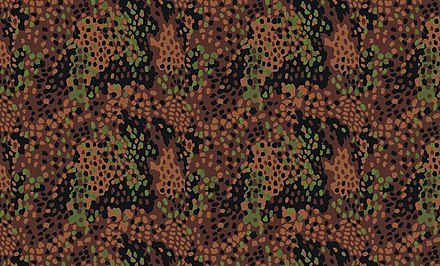
Camouflage is the use of any combination of materials, coloration, or illumination for concealment, either by making animals or objects hard to see, or by disguising them as something else. Examples include the leopard's spotted coat, the battledress of a modern soldier, and the leaf-mimic katydid's wings. A third approach, motion dazzle, confuses the observer with a conspicuous pattern, making the object visible but momentarily harder to locate. The majority of camouflage methods aim for crypsis, often through a general resemblance to the background, high contrast disruptive coloration, eliminating shadow, and countershading. In the open ocean, where there is no background, the principal methods of camouflage are transparencying, silveringing, and countershading, while the ability to produce light is among other things used for counter-illumination on the undersides of cephalopods such as squid. Some animals, such as chameleons and octopuses, are capable of actively changing their skin pattern and colors, whether for camouflage or for signalling. It is possible that some plants use camouflage to evade being eaten by herbivores.

The Desert Battle Dress Uniform (DBDU) is a U.S. arid-environment camouflage battle uniform that was used by the United States Armed Forces from the early 1980s to the early to mid 1990s, most notably during the Persian Gulf War. Although the U.S. military has long since abandoned the pattern, it is still in widespread use by militaries across the world as of the early 2020s.

Flecktarn is a family of three-, four-, five- or six-color disruptive camouflage patterns, the most common being the five-color pattern, consisting of dark green, grey-green, red brown, and black over a light green or tan base depending on the manufacturer. The original German five-color pattern was designed for use in European temperate woodland terrain. A three-color variation called Tropentarn is intended for arid and desert conditions; the German Bundeswehr wore it in Afghanistan.

A military uniform is a standardised dress worn by members of the armed forces and paramilitaries of various nations.

A combat uniform, also called field uniform, battledress or military fatigues, is a casual type of uniform used by military, police, fire and other public uniformed services for everyday fieldwork and combat duty purposes, as opposed to dress uniforms worn in functions and parades. It generally consists of a jacket, trousers and shirt or T-shirt, all cut to be looser and more comfortable than more formal uniforms. Design may depend on regiment or service branch, e.g. army, navy, air force, marines, etc. In the army branches, fabrics tend to come in camouflage, disruptive pattern or else green, brown or khaki monochrome, in order to approximate the background and make the soldier less visible in nature. In Western dress codes, field uniform is considered equivalent to civilian casual wear. As such, field uniform is considered less formal than service dress uniform, generally aimed at office or staff use, as well as mess dress uniform, and full dress uniform.
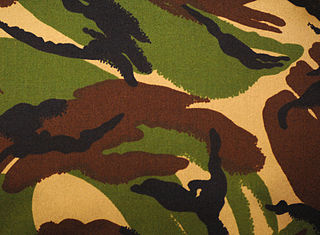
Disruptive Pattern Material (DPM) is the commonly used name of a camouflage pattern used by the British Armed Forces as well as many other armed forces worldwide, particularly in former British colonies.

Military camouflage is the use of camouflage by an armed force to protect personnel and equipment from observation by enemy forces. In practice, this means applying colour and materials to military equipment of all kinds, including vehicles, ships, aircraft, gun positions and battledress, either to conceal it from observation (crypsis), or to make it appear as something else (mimicry). The French slang word camouflage came into common English usage during World War I when the concept of visual deception developed into an essential part of modern military tactics. In that war, long-range artillery and observation from the air combined to expand the field of fire, and camouflage was widely used to decrease the danger of being targeted or enable surprise. As such, military camouflage is a form of military deception in addition to cultural functions such as political identification.

Tiger stripe is the name of a group of camouflage patterns developed for close-range use in dense jungle during jungle warfare by the South Vietnamese Armed Forces and adopted in late 1962 to early 1963 by US Special Forces during the Vietnam War. During and after the Vietnam War, the pattern was adopted by several other Asian countries. It derives its name from its resemblance to a tiger's stripes and were simply called "tigers." It features narrow stripes that look like brush-strokes of green and brown, and broader brush-strokes of black printed over a lighter shade of olive or khaki. The brush-strokes interlock rather than overlap, as in French Lizard pattern (TAP47) from which it apparently derives.
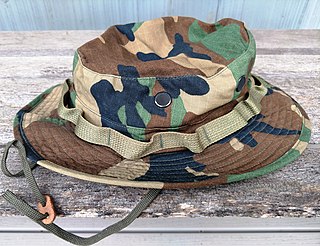
A boonie hat or booney hat is a type of wide-brim sun hat commonly used by military forces in hot tropical climates. Its design is similar to a bucket hat but with a stiffer brim.

The lizard pattern is a family of many related designs of military camouflage pattern, first used by the French Army on uniforms from 1947 to the late 1980s. It was based on the British paratroopers' Denison smock. The use of the pattern is widespread in Africa, despite its association with France, because armed factions and militaries tend to obtain them from whichever source has it available.

Leibermuster is a German military camouflage pattern first used in 1945. It was the last of a family of German World War II camouflage patterns. The pattern was issued on a very limited basis to combat units before the war ended. It consists of bold irregular areas of black printed over brown and green on a pale background.

The following is a general overview of the Heer main uniforms, used by the German Army prior to and during World War II.

Splittertarnmuster, Splittertarn or Splittermuster (splinter-pattern) is a four-colour military camouflage pattern developed by Germany in the late 1920s, first issued to the Reichswehr in 1931.

Aircraft camouflage is the use of camouflage on military aircraft to make them more difficult to see, whether on the ground or in the air. Given the possible backgrounds and lighting conditions, no single scheme works in every situation. A common approach has been a form of countershading, the aircraft being painted in a disruptive pattern of ground colours such as green and brown above, sky colours below. For faster and higher-flying aircraft, sky colours have sometimes been used all over, while helicopters and fixed-wing aircraft used close to the ground are often painted entirely in ground camouflage. Aircraft flying by night have often been painted black, but this actually made them appear darker than the night sky, leading to paler night camouflage schemes. There are trade-offs between camouflage and aircraft recognition markings, and between camouflage and weight. Accordingly, visible light camouflage has been dispensed with when air superiority was not threatened or when no significant aerial opposition was anticipated.
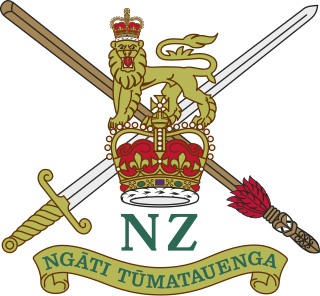
The New Zealand Army uniform has changed over the years from that of the original Armed Constabulary of the 1800s to the modern Army Combat Uniform style in use by the majority of world armies today. While British Army influence has always been strong, distinctive New Zealand features have gradually developed. From 2013 the New Zealand Army uniform underwent a complete redesign with a new and distinctive camouflage pattern unique to the NZDF.

Strichtarn was a military camouflage pattern developed in East Germany and used from 1965 to 1990. The pattern was also used by several other militaries and non-state forces, notably in Africa.

The Wz. 93 Pantera pattern has become the standard camouflage of the Polish Armed Forces. It is the successor of the wz. 89 Puma pattern, and entered service in 1993. It differs from Puma in having stronger contrast, resulting in better disruptive camouflage.

The Rhodesian Brushstroke is a brushstroke-type camouflage pattern used by the Rhodesian Security Forces from 1965 until its replacement by a vertical lizard stripe in 1980.
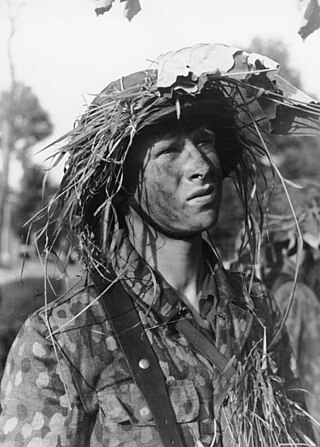
German World War II camouflage patterns formed a family of disruptively patterned military camouflage designs for clothing, used and in the main designed during the Second World War. The first pattern, Splittertarnmuster, was designed in 1931 and was initially intended for Zeltbahn shelter halves. The clothing patterns developed from it combined a pattern of interlocking irregular green, brown, and buff polygons with vertical "rain" streaks. Later patterns, all said to have been designed for the Waffen-SS by Johann Georg Otto Schick, evolved into more leaf-like forms with rounded dots or irregular shapes. Camouflage smocks were designed to be reversible, providing camouflage for two seasons, whether summer and autumn, or summer and winter (snow). Distribution was limited to the Waffen-SS, ostensibly because of a patent, though variants were used by other units, including the Luftwaffe. Production was limited by shortage of materials, especially of high quality waterproof cotton duck.

Snow camouflage is the use of a coloration or pattern for effective camouflage in winter, often combined with a different summer camouflage. Summer patterns are typically disruptively patterned combinations of shades of browns and greys, up to black, while winter patterns are dominated by white to match snowy landscapes.
